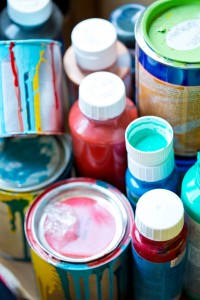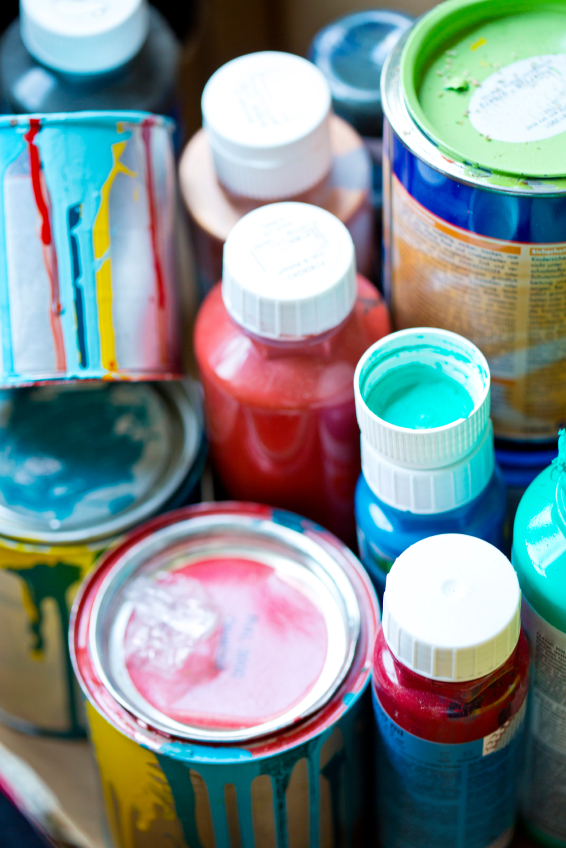
VOCs, also known as Volatile Organic Compounds, are a group of carbon-based chemicals with a superpower: they can easily evaporate into the air at room temperature, and there they hang and wait for a nice set of lungs to inhale them.
When there are high levels of VOCs in a room, most people can smell them, but it should be noted that some VOCs have no odor, so just because a room smells “safe” doesn’t mean it is. In other words, the odor does not indicate any level of risk of inhaling this dangerous group of chemicals.
Common VOCs in Our Daily Lives
Toxic dangers are lurking all around us in the form of numerous VOCs. Some of the most common ones we encounter are:
- Acetone – used as a solvent for many plastics and thinning polyester resin. Acetone is also commonly used to degrease and clean tools and can be found in paints and varnishes.
- Benzene – A chemical used to make other chemicals that are used to make many plastics and polymers.
- Ethylene glycol – Mostly used as a medium for convective heat transfer, as in cars and liquid-cooled computers. Ethylene glycol is also commonly used in cold water air conditioning systems where the chillers are placed outside.
- Formaldehyde – A colorless, flammable chemical widely used to manufacture building materials and household products.
- Methylene chloride – This chemical has a wide range of uses, everything from a paint stripper and degreaser to a chemical used in the food industry to decaffeinate coffee and tea.
- Perchloroethylene – This volatile, highly stable, and nonflammable VOC is widely used in dry cleaning and to degrease metal parts in the automotive industry. It is also used in a few consumer products such as paint strippers and spot removers.
- Toluene – Has many uses but most commonly used as a solvent for paints, paint thinners, silicone sealants, and many chemical reactants, rubber, printing ink, adhesives (glues), lacquers, and disinfectants.
- Xylene – Mainly used in the production of polyethylene terephthalate (PET) plastic bottles and polyester clothing.
- 1,3-butadiene – A material most commonly used for the production of car tires.
What Kinds of Building Materials and Home Products Contain VOCs?
You would be shocked, and perhaps a bit nervous, to learn of all of the products currently in your home that releases or “off-gas” VOCs. Some common sources of these toxic chemicals are:
- Air fresheners
- Air cleaners that produce ozone
- Cleaning and disinfecting chemicals
- Cosmetics
- Gasoline
- Mothballs
- Vehicle exhaust (when the car is running in an attached garage)
- Paints
- Carpets and adhesives
- Composite wood products
- Sealing caulks
- Solvents
- Upholstery fabrics
- Varnishes
- Vinyl Floors
- Dry cleaning
- Smoking
- Wood burning stoves
Studies have shown that the level of VOCs indoors in our homes is generally two to five times higher than the level of VOC’s outdoors. These VOC concentrations in indoor air depend on many factors, including:
- The amount of VOCs in a particular product
- The rate at which the VOCs evaporate and are released into the air
- The volume of the air in the room or building
- How well that room or building is ventilated
The Health Effects of VOC Exposure
Obviously, inhaling any kind of toxic chemical is not a great thing, but in our modern life, it’s sometimes hard to avoid. The actual health risks from inhaling VOCs are dependent on how much is in the air and how often a person breathes them in. Health experts look at short-term (acute) exposures as hours to days and long-term (chronic) exposures as years (and in the worst-case scenario – a lifetime of exposure).
Studies have now suggested that breathing even low levels of VOCs for extended periods of time can lead to the risk of certain health issues.
Common symptoms of acute exposure to high levels of VOCs include:
- Headaches
- Eye, nose, and throat irritation
- Dizziness
- Nausea / Vomiting
- Worsening of asthma symptoms
Chronic exposure to high levels of VOCs may lead to an increased risk of:
- Cancer
- Liver damage
- Kidney damage
- Central Nervous System damage
Are Any Levels of VOCs Safe?
The best thing for you and your family’s health is to limit your exposure to materials and products that contain VOCs as much as possible. Because most health studies have been conducted on single chemicals, there are no federal health-based standards for VOCs as a group and it’s hard to truly know the negative health effects from exposure to combinations of chemicals.
What scientists do know is that certain people are at greater risk from VOC exposure, such as those with respiratory problems like asthma and chronic allergies, the very young and very old, and those people who have a heightened sensitivity to chemicals.
What Can You Do about the VOCs in Your Home?
There are home screening kits you may purchase to measure the total VOC levels in your home, but these kits won’t magically solve your problems. Instead of testing, it is better to conduct a thorough inspection of your home to find some of the common sources of VOCs listed earlier.
If you have trouble locating possible sources of VOCs, it is recommended you hire a professional indoor air quality specialist. Once the probable VOC sources have been identified, you can take the necessary steps to reduce your exposure by:
- Removing and replacing harmful products.
- Removing opened but unused chemicals from garages and basements. Even chemicals that have been stored in closed containers can leak and release VOCs into the air. You will want to check with your city or county to find out where your household hazardous waste collection sites are.
- Increase ventilation in your home by opening doors and windows, and use fans to maximize air brought in from outside.
- Keep both the temperature and relative humidity in your home as low as possible (while still being comfortable) because VOCs will off-gas at higher levels under warmer conditions with high humidity.
- When buying any new product for your home, whether it’s paint, stain, new furniture, or flooring, always be sure to buy products with low or no VOC content.
Ambient – Your Source for urea formaldehyde-free Bamboo and Eucalyptus Flooring
We for formaldehyde, another chemical found in many products like furniture, plastics, and carpeting that can cause health issues. We do this because we want you to know and trust that all of our products will be safe for you and your family.
If you are looking for new flooring and want to be sure it’s 100% safe, about our beautiful bamboo and eucalyptus floors.
Last update of the article: 11/20/2020.

About the Author
James is your friendly neighborhood content writer here at the Green Living Blog. With a passion for all things sustainable, he’s your go-to guru for everything eco-friendly. Armed with a treasure trove of wisdom about sustainable living, recycling, and environmentally conscious practices, James is on a mission. He’s here to make sure you not only protect your family but also keep Mother Earth smiling. 😊🌎 When he’s not busy sharing eco-friendly insights, James can often be found teaching his cat that compost bins make the purr-fect hideaway. 🐱♻️ Join James on his quest to uncover the secrets of defeating wasteful habits while leaving the lightest footprint on our precious planet’s ecosystem.

